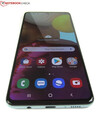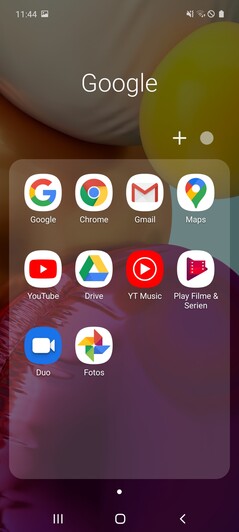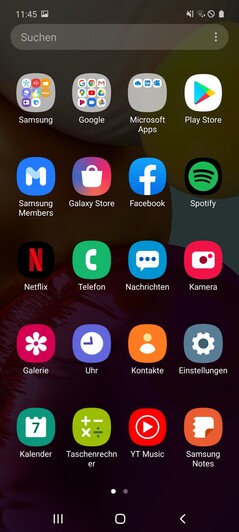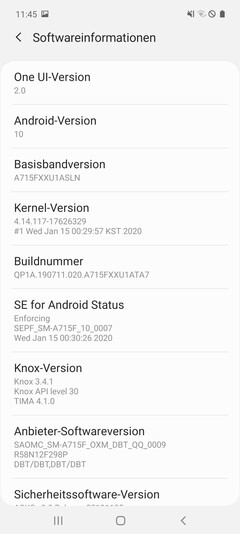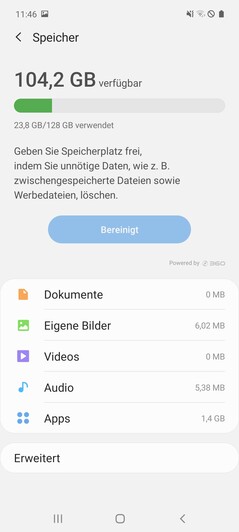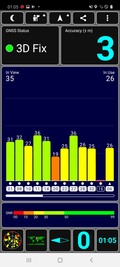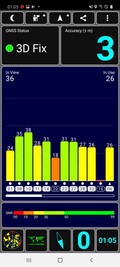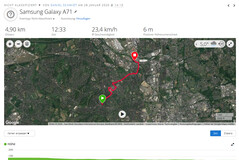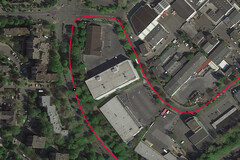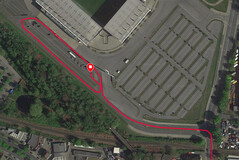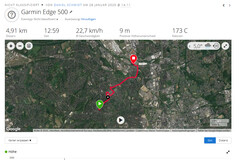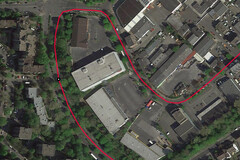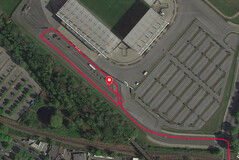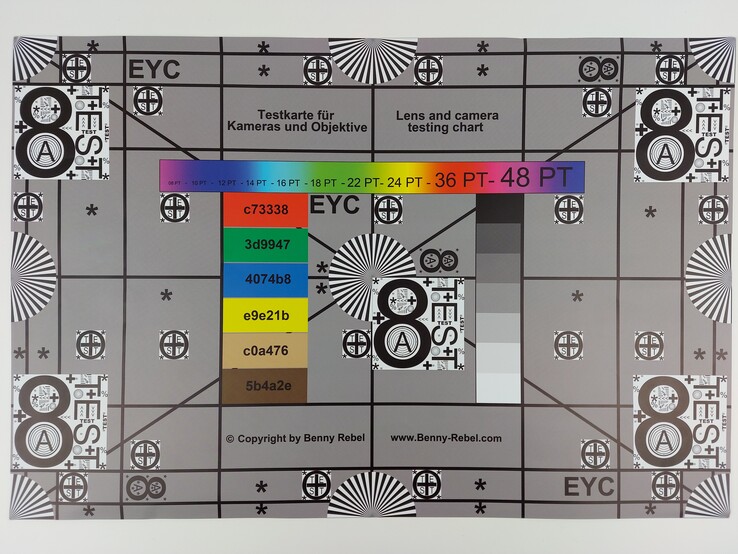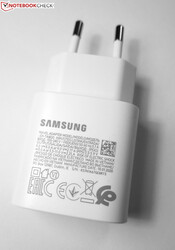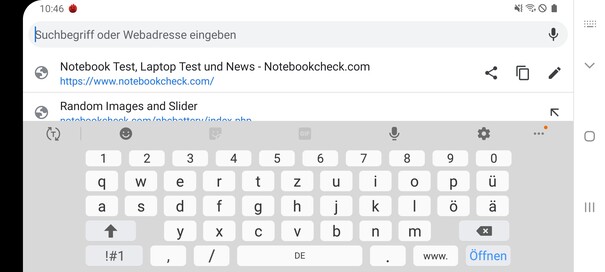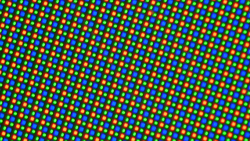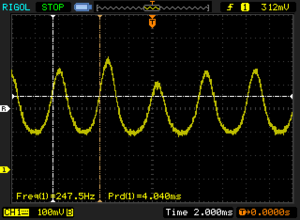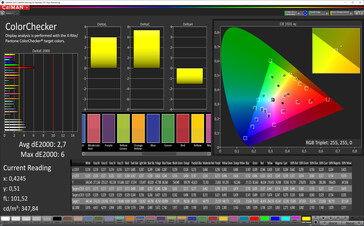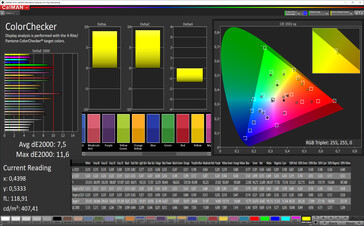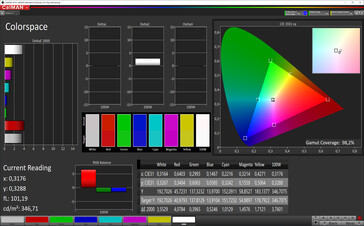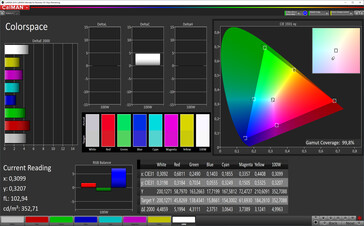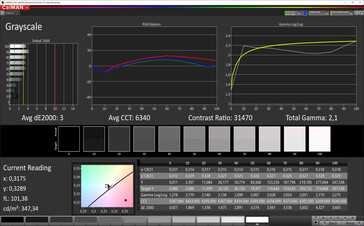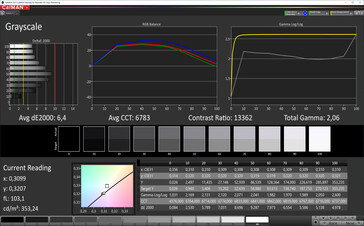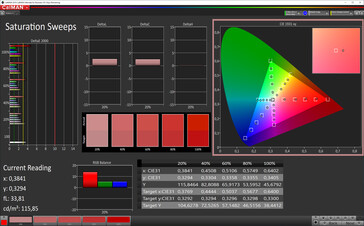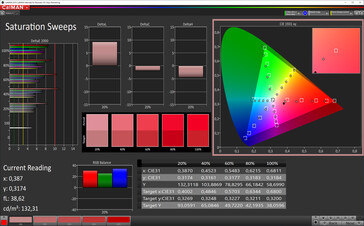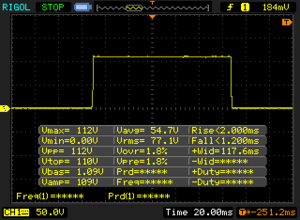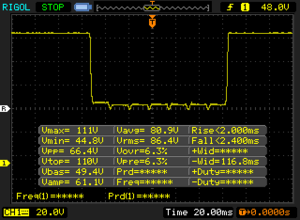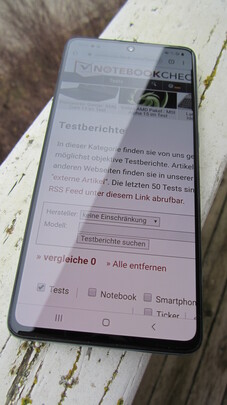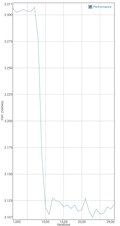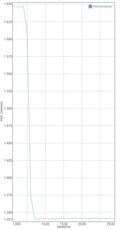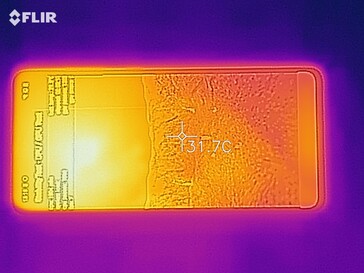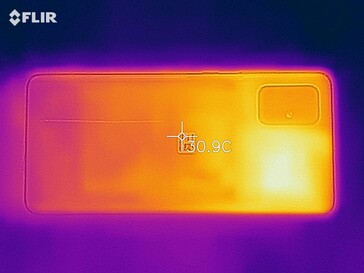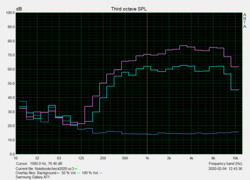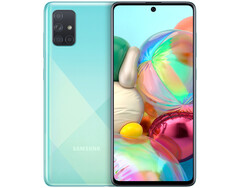Samsung Galaxy A71 Smartphone Review: An XXL display and quad cameras
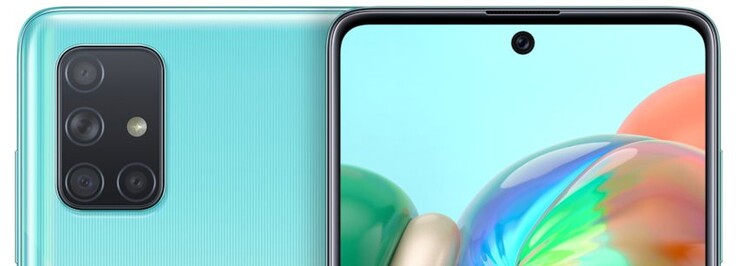
Samsung has refreshed the design and hardware of its popular Galaxy A series. This benefits our test candidate, the Galaxy A71, as it is one of the first representatives of the Galaxy A series in 2020.
With a diagonal of 6.7-inches, the mid-range smartphone is practically the same size as its predecessor, the Galaxy A70. The A71 also continues to use a Super AMOLED display, which has a resolution of 2400x1080 pixels. The changes to the rest of the hardware are largely limited to minor details, too. Samsung has swapped the Snapdragon 675 in the Galaxy A70 for a Snapdragon 730, for instance.
There is one big innovation, though. Samsung has completely revised the rear-facing camera unit for the A71, which is made up of four lenses. Additionally, the main camera has twice the resolution of its predecessor, with Samsung including a 64 MP sensor this time around. The Galaxy A70 had three rear-facing cameras too, with the South Korean company including ultra-wide-angle and bokeh sensors to complement the 32 MP main camera. By contrast, the A71 includes a 5 MP macro sensor alongside its three other sensors.
With that in mind, we shall endeavour to determine what these upgrades offer in total and if switching from the Galaxy A70 to the A71 is a worthwhile upgrade.
Device Comparison
Rating | Date | Model | Weight | Drive | Size | Resolution | Price |
|---|---|---|---|---|---|---|---|
| 82.1 % v7 (old) | 02 / 2020 | Samsung Galaxy A71 SD 730, Adreno 618 | 179 g | 128 GB UFS 2.0 Flash | 6.70" | 2400x1080 | |
| 86.1 % v6 (old) | 06 / 2019 | Samsung Galaxy A70 SD 675, Adreno 612 | 183 g | 128 GB UFS 2.0 Flash | 6.70" | 2400x1080 | |
| 79 % v7 (old) | 01 / 2020 | Huawei P30 Lite New Edition Kirin 710, Mali-G51 MP4 | 159 g | 256 GB UFS 2.1 Flash | 6.15" | 2312x1080 | |
| 80.3 % v7 (old) | 01 / 2020 | Motorola One Hyper SD 675, Adreno 612 | 210 g | 128 GB UFS 2.0 Flash | 6.50" | 2340x1080 | |
| 80.2 % v7 (old) | 07 / 2019 | Google Pixel 3a SD 670, Adreno 616 | 147 g | 64 GB eMMC Flash | 5.60" | 2220x1080 |
Case - A lightweight handset despite its XXL case
Externally, it is hard to tell the A71 apart from its predecessor, the Galaxy A70. Both have nice narrow bezels, Gorilla Glass 3 to protect their FHD+ displays, in-screen fingerprint sensors and slim 20:9 aspect ratios, for instance.
The A71 retains the high-quality workmanship and appealing feel of its predecessor too, even if the chassis remains plastic and it continues to lack an IP certification. The absence of metal has its advantages, though. Despite having an XXL display, the A71 weighs a mere 179 g.
Samsung sells the A71 for 469 Euros (~$508) online, and it comes in several colours. Currently, the A71 comes in Prism Crush Blue, the colour of our review unit, Prism Crush Black or Prism Crush White. According to Samsung, colour options will vary by country and region.
Arguably, the biggest visual difference between the A71 and the Galaxy A70 is the implementation of their front-facing cameras. While the Galaxy A70 has a notch, the 32 MP selfie camera in the A71 sits behind a small hole in the display. This change increases the overall display area minimally but it does make the new Galaxy A-series addition look a bit more elegant than its predecessor.
Connectivity - Dual SIM and 128 GB of storage in this mid-range Galaxy
The A71 offers real dual SIM connectivity, meaning that it can hold two nano-SIM cards and a microSD card simultaneously. The device can expand its 128 GB of UFS 2.0 flash storage with up to 512-GB microSD cards, for reference.
With its USB Type-C port, which still only operates at USB 2.0 speeds, the A71 also supports USB On-The-Go (OTG) functionality. The 3.5 mm jack and internal connections of Bluetooth 5.0 and NFC from the Galaxy A70 have remained too. Additionally, thanks to DRM Widevine L1 support, the A71 can also stream HD videos from DRM-protected services like Amazon Prime Video or Netflix.
Software - Android 10, One UI 2.0 and Bixby onboard
Android 10 runs on the A71 out of the box, atop of which Samsung has added One UI 2.0. The differences between the in-house OS and stock Android are small, meaning that people should quickly find their way around when switching from other versions of Android. Our review unit had the January 1, 2020, set of Android security patches installed at the time of testing in mid-February.
Nice extras in One UI are the dual messenger functionality, which allows you to be signed into two accounts for the same messenger app, and Bixby, Samsung's smart assistant. Bixby has a dedicated user interface called Bixby Home, which can be started with a swipe to the right on the home screen of the default launcher.
Samsung holds back with bloatware, too. In addition to the usual suite of Google and Samsung apps, the A71 comes pre-loaded with only a handful of third-party applications. These include Outlook, LinkedIn and Spotify. Most can be uninstalled. A little more than 104 GB of the nominal 128 GB storage space was free on our test device when we first booted it, for reference.
Communication & GPS - Wide LTE coverage
The A71 connects to mobile networks via GSM over 850, 900, 1800 and 1900 MHz, UMTS over 850, 900, 1900 and 2100 MHz and 4G via Bands 1, 2, 3, 4, 5, 7, 8, 12, 13, 17, 20, 26, 28, 38, 40 and 41. The device covers significantly more LTE frequencies than its predecessor does and utilises LTE Cat.11 for up to 600 Mb/s download and 75 Mb/s upload speeds.
Just like its predecessor, the A71 supports up to Wi-Fi 5 connectivity with its Qualcomm WCN3980 modem. The A71 matched the download speeds of the Galaxy A70 in our Wi-Fi tests. While they have acceptable transfer speeds, there are devices with much faster modems than those that Samsung has included in the A71 and Galaxy A70. The A71 is a bit faster at uploading data than the Galaxy A70 is though, according to iperf3 Client. The A71 averaged 317 Mb/s in this test for reference, while the Galaxy A70 managed 264 Mb/s. We would not call that a clear advantage, though.
When connected to our Netgear Nighthawk AX12 reference router, the A71 also delivered consistently high transfer speeds. We did notice a slight dip at the beginning of the iperf3 Client upload test, but this is no wider cause for concern here.
| Networking | |
| iperf3 transmit AX12 | |
| Google Pixel 3a | |
| Samsung Galaxy A71 | |
| Motorola One Hyper | |
| Samsung Galaxy A70 | |
| Huawei P30 Lite New Edition | |
| iperf3 receive AX12 | |
| Google Pixel 3a | |
| Samsung Galaxy A70 | |
| Samsung Galaxy A71 | |
| Motorola One Hyper | |
| Huawei P30 Lite New Edition | |
The A71 uses BeiDou, Galileo, Glonass and GPS for location services. In our tests, our review unit could find a satellite fix with up to 3 metres accuracy within a few seconds regardless of whether we tested it indoors or outdoors.
As always, we checked the precision of our review unit's GPS module under real conditions by taking it on a short bike ride and comparing its route against that recorded by a Garmin Edge 500.
In short, the A71 mapped our route just as accurately as the professional navigation device did, save for a few minor deviations.
Telephone Functions & Call Quality - VoLTE and VoWiFi in Samsung's mid-range smartphone
In addition to a microSD card reader, the A71 also has two nano SIM card slots, as we mentioned earlier. If you plan to use the device's dual-SIM functionality, then you can set a default for voice calls, messages and data services individually.
The A71 also supports voice over LTE (VoLTE) and Wi-Fi calls (VoWiFi). However, while VoLTE can be activated from within the main settings menu, you must go into the phone app to switch on VoWiFi.
In our tests, the A71 convinced us as having decent call quality. Quiet voices sometimes present the device with slight difficulties because it cannot always transmit them properly, but both sides of the call remain intelligible irrespective of whether you are calling a landline or another smartphone.
Cameras - Good pictures, but only in daylight
Cameras are one of the biggest differences between A71 and its predecessor, the Galaxy A70. Samsung has included four rear-facing sensors in the A71 rather than the three that it included in the Galaxy A70. These are joined by an LED flash. The main camera in the A71 is a 64 MP sensor too, which offers twice the resolution that the main sensor in the Galaxy A70 does.
However, the A71 always shoots in 16 MP. The device does this by combining four neighbouring pixels into one larger pixel, a process often called pixel binning. While this should allow the device to capture more light data per pixel, the default camera app does not support long exposure times. On the contrary, the app responds as soon as we press the shutter button.
Specifically, the A71 has a 64 MP main camera (0.8 µm, 1/1.73"), along with a 12 MP ultra-wide-angle lens (1.12 µm, 1/3.0"), a 5 MP depth sensor (1.12 µm, 1/5.0") and a 5 MP macro lens (1.12 µm, 1/5.0“). Meanwhile, the front-facing camera resolves at 32 MP (0.8 µm, 1/2.74").
Videos can be recorded at 4K and 30 FPS using the front or rear-facing cameras.
Overall, the A71 delivers solid picture quality for a mid-range smartphone. With its quadruple lens system, the smartphone takes good pictures in daylight, see scenes 1 and 2, which appear lively, sharp and dynamic. However, it cannot pick out fine image details quite as well as other middle-class rivals, though. The Google Pixel 3a is much better in this respect.
Low-light shots, like scene 3, pose some challenges for the main camera in the A71, too. Image details are completely lost here, with only the outlines of objects being present. The Galaxy A70 also struggled with this issue.
The A71 convinced us under controlled lighting conditions, even if our test chart looks a bit pale towards its outer edges. As we already observed in our other test photos, the A71 oversaturates colours to make images look more dynamic and vivid.
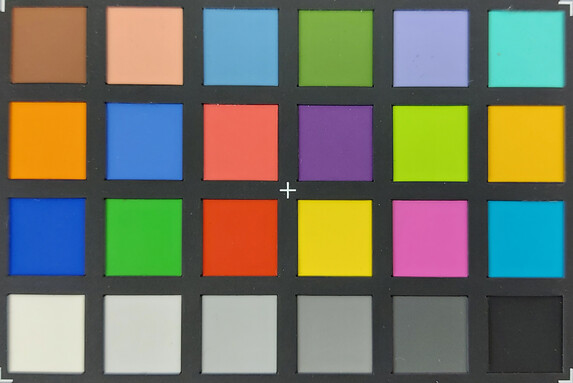

Accessories & Warranty - 24 months' warranty and a 25 W fast charger
Samsung includes a modular 25 W charger in the box, which operates at up to 11 V/2.25 A. A USB Type-C to Type-C cable, a pair of headphones, a SIM tool and a quick-start guide are included, too.
The manufacturer does not offer any special accessories for the A71 at the time of writing.
The A71 also comes with a 24-month limited manufacturer's warranty. Please see our Guarantees, Return Policies & Warranties FAQ for country-specific information.
Input Devices & Operation - A function key instead of a power button in the Galaxy A71
The 10-point touchscreen of the A71 reacts quickly to inputs and implements them precisely even into the corners of the display. If you want to operate the 6.7-inch smartphone with one hand but find it difficult to reach every part of the display with your fingers, then you can activate a one-handed mode. Doing so reduces the display size by about a third. You can toggle one-handed mode by tapping the capacitive home button twice, for reference.
Samsung includes an in-screen fingerprint scanner, which reliably unlocks our review unit. The A71 also supports unlocking via face recognition, although it uses the front-facing camera to do so rather than an infrared sensor. Face recognition works relatively well in darker environments though, but only when the "Brighten screen" option is activated in the biometric sub-menu of Settings.
What is a power button on other smartphones is what Samsung calls the function button on the A71. Simply, the button can do more than just power on or off the device. While the function button switches on the A71 or wakes it up from standby, it also has two other uses. If you press it twice, for instance, then the device brings up your most recently used app. If you hold the button down for longer this opens Bixby Voice, Samsung's voice assistant. You cannot switch off the smartphone directly by using the function key, either. Only pressing the function key and volume down simultaneously will bring up the power menu, from which you can power off or restart the device.
Using the default keyboard in portrait mode
As with the Galaxy A70, the 6.7-inch Super AMOLED display in the A71 is a highlight of the device. The display still has an FHD+ resolution of 2400x1080 pixels, which results in a high pixel density of 393 PPI. In short, the A71 displays content sharply.
Samsung has once again tweaked the brightness of its new mid-range handset. Compared to the Galaxy A70, which averaged 552.4 cd/m² during our tests, the average peak luminosity of the A71 reached 646.3 cd/m² according to X-Rite i1Pro 2. APL50, a more practical test that records luminosity by evenly distributing light and dark areas across the display, recorded the device hitting 834 cd/m².
Sadly, the panel uses pulse width modulation (PWM) to regulate luminosity. The panel in our review unit flickers at between 121.4 and 247.5 Hz, frequencies that people with sensitive eyes may find annoying.
| |||||||||||||||||||||||||
Brightness Distribution: 95 %
Center on Battery: 629 cd/m²
Contrast: ∞:1 (Black: 0 cd/m²)
ΔE ColorChecker Calman: 2.7 | ∀{0.5-29.43 Ø4.78}
ΔE Greyscale Calman: 3 | ∀{0.09-98 Ø5}
98.2% sRGB (Calman 2D)
Gamma: 2.1
CCT: 6340 K
| Samsung Galaxy A71 AMOLED, 2400x1080, 6.7" | Samsung Galaxy A70 Super AMOLED, 2400x1080, 6.7" | Huawei P30 Lite New Edition IPS, 2312x1080, 6.2" | Motorola One Hyper IPS, 2340x1080, 6.5" | Google Pixel 3a P-OLED, 2220x1080, 5.6" | |
|---|---|---|---|---|---|
| Screen | -19% | -40% | -27% | -35% | |
| Brightness middle (cd/m²) | 629 | 554 -12% | 507 -19% | 455 -28% | 403 -36% |
| Brightness (cd/m²) | 646 | 552 -15% | 481 -26% | 444 -31% | 411 -36% |
| Brightness Distribution (%) | 95 | 98 3% | 88 -7% | 78 -18% | 96 1% |
| Black Level * (cd/m²) | 0.38 | 0.53 | |||
| Colorchecker dE 2000 * | 2.7 | 3.3 -22% | 4.72 -75% | 3.86 -43% | 5.1 -89% |
| Colorchecker dE 2000 max. * | 6 | 9.2 -53% | 7.84 -31% | 6.59 -10% | 11 -83% |
| Greyscale dE 2000 * | 3 | 3.4 -13% | 5.5 -83% | 4 -33% | 2 33% |
| Gamma | 2.1 105% | 2.08 106% | 2.158 102% | 2.3 96% | 2.22 99% |
| CCT | 6340 103% | 6606 98% | 7596 86% | 7367 88% | 6589 99% |
| Contrast (:1) | 1334 | 858 |
* ... smaller is better
Screen Flickering / PWM (Pulse-Width Modulation)
| Screen flickering / PWM detected | 247.5 Hz | ≤ 99 % brightness setting | |
The display backlight flickers at 247.5 Hz (worst case, e.g., utilizing PWM) Flickering detected at a brightness setting of 99 % and below. There should be no flickering or PWM above this brightness setting. The frequency of 247.5 Hz is relatively low, so sensitive users will likely notice flickering and experience eyestrain at the stated brightness setting and below. In comparison: 53 % of all tested devices do not use PWM to dim the display. If PWM was detected, an average of 8111 (minimum: 5 - maximum: 343500) Hz was measured. | |||
The display not only impresses with its high maximum brightness but also good colour accuracy. The Natural display mode, for instance, delivers almost ideal colour and greyscale Delta E deviations. There is also a Vivid mode, which makes everything look more colourful. While this mode is not quite as accurate as Natural is, the difference in colour accuracy is not noticeable to the naked eye.
Display Response Times
| ↔ Response Time Black to White | ||
|---|---|---|
| 3.2 ms ... rise ↗ and fall ↘ combined | ↗ 2 ms rise | |
| ↘ 1.2 ms fall | ||
| The screen shows very fast response rates in our tests and should be very well suited for fast-paced gaming. In comparison, all tested devices range from 0.1 (minimum) to 240 (maximum) ms. » 13 % of all devices are better. This means that the measured response time is better than the average of all tested devices (20.2 ms). | ||
| ↔ Response Time 50% Grey to 80% Grey | ||
| 4.4 ms ... rise ↗ and fall ↘ combined | ↗ 2 ms rise | |
| ↘ 2.4 ms fall | ||
| The screen shows very fast response rates in our tests and should be very well suited for fast-paced gaming. In comparison, all tested devices range from 0.165 (minimum) to 636 (maximum) ms. » 15 % of all devices are better. This means that the measured response time is better than the average of all tested devices (31.6 ms). | ||
The A71 has many advantages on its side for combating direct sunlight, too. Its high maximum brightness and theoretically infinite contrast ratio combat bright sunlight, as the photo below demonstrates. The A71 has stable viewing angles too, as is typical for devices with AMOLED panels.
Performance - A fast mid-range smartphone
The A71 uses the mid-range Snapdragon 730, an SoC that has eight cores. Qualcomm divides these into a performance cluster that contains two ARM Cortex-A76 cores and a standard cluster, which contains six ARM Cortex-A55 cores. These can clock up to 2.2 GHz and 1.8 GHz, respectively. There is also an Adreno 618 GPU and 6 GB of RAM onboard.
The A71 is currently one of the fastest mid-range smartphones on the market. Our review unit remained at the forefront of synthetic benchmarks during our tests, but it cannot decisively differentiate itself from its equally strong competitors.
The Motorola One Hyper, for instance, a device that is powered by the nominally weaker Snapdragon 675, slightly outperforms the A71 in system benchmarks like PCMark. By contrast, the Snapdragon 730 in the A71 has a significant advantage in graphics-intensive tests like GFXBench.
| GFXBench 3.1 | |
| on screen Manhattan ES 3.1 Onscreen (sort by value) | |
| Samsung Galaxy A71 | |
| Samsung Galaxy A70 | |
| Huawei P30 Lite New Edition | |
| Google Pixel 3a | |
| Average Qualcomm Snapdragon 730 (22 - 27, n=4) | |
| Average of class Smartphone (11 - 166, n=158, last 2 years) | |
| 1920x1080 Manhattan ES 3.1 Offscreen (sort by value) | |
| Samsung Galaxy A71 | |
| Samsung Galaxy A70 | |
| Huawei P30 Lite New Edition | |
| Google Pixel 3a | |
| Average Qualcomm Snapdragon 730 (24 - 30, n=4) | |
| Average of class Smartphone (8.4 - 413, n=158, last 2 years) | |
| AnTuTu v8 - Total Score (sort by value) | |
| Samsung Galaxy A71 | |
| Huawei P30 Lite New Edition | |
| Average Qualcomm Snapdragon 730 (247507 - 247877, n=2) | |
| AnTuTu v7 - Total Score (sort by value) | |
| Samsung Galaxy A70 | |
| Google Pixel 3a | |
| Average Qualcomm Snapdragon 730 (202586 - 210836, n=2) | |
| AnTuTu v6 - Total Score (sort by value) | |
| Samsung Galaxy A70 | |
| Google Pixel 3a | |
| Average Qualcomm Snapdragon 730 (159151 - 171518, n=2) | |
The A71 makes a slightly bigger leap in terms of browser performance, though. The differences between the Samsung smartphone and its competitors are somewhat larger here. Subjectively, web-browsing feels fast on the A71, although the nominally weaker Galaxy A70 also gave us this impression.
| Jetstream 2 - 2.0 Total Score | |
| Average of class Smartphone (23.8 - 387, n=154, last 2 years) | |
| Average Qualcomm Snapdragon 730 (36.6 - 50.1, n=4) | |
| Samsung Galaxy A70 (Chrome 74.0.3729.157) | |
| Samsung Galaxy A71 (Chrome 79.0.3945.136) | |
| Google Pixel 3a | |
| Huawei P30 Lite New Edition (Chrome 79) | |
| JetStream 1.1 - Total Score | |
| Samsung Galaxy A70 (Chrome 74.0.3729.157) | |
| Average Qualcomm Snapdragon 730 (65.3 - 87.5, n=4) | |
| Samsung Galaxy A71 (Chrome 79.0.3945.136) | |
| Huawei P30 Lite New Edition (Chrome 79) | |
| Speedometer 2.0 - Result 2.0 | |
| Average of class Smartphone (15.2 - 643, n=128, last 2 years) | |
| Samsung Galaxy A70 (Chrome 74.0.3729.157) | |
| Average Qualcomm Snapdragon 730 (32.8 - 46.5, n=4) | |
| Samsung Galaxy A71 (Chrome 79.0.3945.136) | |
| Huawei P30 Lite New Edition (Chrome 79) | |
| WebXPRT 3 - Overall | |
| Average of class Smartphone (38 - 380, n=35, last 2 years) | |
| Samsung Galaxy A70 (Chrome 74.0.3729.157) | |
| Average Qualcomm Snapdragon 730 (60 - 86, n=4) | |
| Samsung Galaxy A71 (Chrome 79.0.3945.136) | |
| Huawei P30 Lite New Edition (Chrome 79) | |
| Octane V2 - Total Score | |
| Average of class Smartphone (2228 - 121337, n=201, last 2 years) | |
| Average Qualcomm Snapdragon 730 (12771 - 17501, n=4) | |
| Samsung Galaxy A70 (Chrome 74.0.3729.157) | |
| Samsung Galaxy A71 (Chrome 79.0.3945.136) | |
| Google Pixel 3a | |
| Huawei P30 Lite New Edition (Chrome 79) | |
| Mozilla Kraken 1.1 - Total | |
| Huawei P30 Lite New Edition (Chrome 79) | |
| Google Pixel 3a | |
| Samsung Galaxy A71 (Chrome 79.0.3945.136) | |
| Average Qualcomm Snapdragon 730 (2564 - 3436, n=4) | |
| Samsung Galaxy A70 (Chrome 74.0.3729.157) | |
| Average of class Smartphone (257 - 28190, n=156, last 2 years) | |
* ... smaller is better
The A71 must tie for third with the Galaxy A70 and Motorola One Hyper, with little to nothing separating their read and write speeds. Only the Huawei P30 Lite New Edition stands out clearly here, especially with its strong 4K transfer and sequential read speeds.
| Samsung Galaxy A71 | Samsung Galaxy A70 | Huawei P30 Lite New Edition | Motorola One Hyper | Google Pixel 3a | Average 128 GB UFS 2.0 Flash | Average of class Smartphone | |
|---|---|---|---|---|---|---|---|
| AndroBench 3-5 | -13% | 53% | 1% | -15% | 2% | 394% | |
| Sequential Read 256KB (MB/s) | 493 | 508 3% | 800 62% | 492.2 0% | 302 -39% | 530 ? 8% | 2223 ? 351% |
| Sequential Write 256KB (MB/s) | 192.4 | 194 1% | 391.1 103% | 190.8 -1% | 253.9 32% | 212 ? 10% | 1838 ? 855% |
| Random Read 4KB (MB/s) | 112.3 | 103.8 -8% | 198.7 77% | 129.4 15% | 63.6 -43% | 130.6 ? 16% | 295 ? 163% |
| Random Write 4KB (MB/s) | 109.6 | 21.95 -80% | 171.6 57% | 106.9 -2% | 99.9 -9% | 101.2 ? -8% | 335 ? 206% |
| Sequential Read 256KB SDCard (MB/s) | 73.4 ? | 76.2 ? 4% | 76.6 ? 4% | 74.3 ? 1% | 68.3 ? -7% | ||
| Sequential Write 256KB SDCard (MB/s) | 57.2 ? | 58.8 ? 3% | 66.8 ? 17% | 53.6 ? -6% | 53.2 ? -7% |
Games - Current titles run smoothly
The A71 is well equipped for playing current games. As our measurements with Gamebench show, PUBG Mobile, for example, runs smoothly even at high details. However, the game remains at 30 FPS despite being set to high frame rates. The same applies to Asphalt 8: Airborne, although we did not encounter stutters here. We would have liked to benchmark Asphalt 9: Legends, too. Strangely enough, the game was not available to download from the Google Play Store.
Emissions - Cool Samsung phone with slight throttling
Temperature
The A71 remained pleasantly cool during our tests and heats up to no more than 34.4 °C even under full load. The device uses tricks internally to keep this cool, though.
As the GFXBench battery test shows, a benchmark that renders a scene 30 times in a row, the A71 throttles its SoC after a short time. There is no noticeable drop in performance though, although GFXBench reports throttling of up to 20%. This still leaves enough power to play games smoothly, in our opinion.
(+) The maximum temperature on the upper side is 34.4 °C / 94 F, compared to the average of 35.2 °C / 95 F, ranging from 21.9 to 247 °C for the class Smartphone.
(+) The bottom heats up to a maximum of 33.7 °C / 93 F, compared to the average of 34 °C / 93 F
(+) In idle usage, the average temperature for the upper side is 25.8 °C / 78 F, compared to the device average of 32.9 °C / 91 F.
Speakers
The A71 has a single speaker that sits on the underside of its frame. The speaker delivers a rounded sound and one that is akin to that of the speaker in the Galaxy A70. Overall, the speaker is good enough for watching YouTube and occasionally listening to music.
You will be rewarded by even better sound quality if you connect external audio equipment like headphones and speakers, though. You can connect these to the device's 3.5 mm jack or Bluetooth, for reference.
Samsung Galaxy A71 audio analysis
(+) | speakers can play relatively loud (85.2 dB)
Bass 100 - 315 Hz
(-) | nearly no bass - on average 31.9% lower than median
(±) | linearity of bass is average (11.5% delta to prev. frequency)
Mids 400 - 2000 Hz
(+) | balanced mids - only 3% away from median
(+) | mids are linear (4.1% delta to prev. frequency)
Highs 2 - 16 kHz
(±) | higher highs - on average 5.3% higher than median
(+) | highs are linear (2.5% delta to prev. frequency)
Overall 100 - 16.000 Hz
(±) | linearity of overall sound is average (20.7% difference to median)
Compared to same class
» 36% of all tested devices in this class were better, 8% similar, 55% worse
» The best had a delta of 11%, average was 35%, worst was 134%
Compared to all devices tested
» 55% of all tested devices were better, 8% similar, 37% worse
» The best had a delta of 4%, average was 24%, worst was 134%
Samsung Galaxy A70 audio analysis
(+) | speakers can play relatively loud (85.3 dB)
Bass 100 - 315 Hz
(-) | nearly no bass - on average 33.5% lower than median
(±) | linearity of bass is average (13.1% delta to prev. frequency)
Mids 400 - 2000 Hz
(+) | balanced mids - only 3.7% away from median
(+) | mids are linear (4.5% delta to prev. frequency)
Highs 2 - 16 kHz
(±) | higher highs - on average 6.2% higher than median
(+) | highs are linear (3.6% delta to prev. frequency)
Overall 100 - 16.000 Hz
(±) | linearity of overall sound is average (22.9% difference to median)
Compared to same class
» 50% of all tested devices in this class were better, 7% similar, 43% worse
» The best had a delta of 11%, average was 35%, worst was 134%
Compared to all devices tested
» 67% of all tested devices were better, 6% similar, 27% worse
» The best had a delta of 4%, average was 24%, worst was 134%
Power Management - A Samsung smartphone with marathon runtimes
Power Consumption
With its Snapdragon 730 SoC, the A71 uses little power and runs almost as energy-efficiently as the Galaxy A70. The Huawei P30 Lite New Edition is a bit more economic than our review unit, though.
| Off / Standby | |
| Idle | |
| Load |
|
Key:
min: | |
| Samsung Galaxy A71 4500 mAh | Samsung Galaxy A70 4500 mAh | Huawei P30 Lite New Edition 3340 mAh | Motorola One Hyper 4000 mAh | Google Pixel 3a 3000 mAh | Average Qualcomm Snapdragon 730 | Average of class Smartphone | |
|---|---|---|---|---|---|---|---|
| Power Consumption | 1% | -30% | 15% | 6% | -30% | ||
| Idle Minimum * (Watt) | 0.63 | 0.66 -5% | 0.95 -51% | 0.61 3% | 0.643 ? -2% | 0.848 ? -35% | |
| Idle Average * (Watt) | 1.49 | 1.69 -13% | 2.1 -41% | 1.56 -5% | 1.235 ? 17% | 1.434 ? 4% | |
| Idle Maximum * (Watt) | 1.51 | 1.8 -19% | 2.4 -59% | 1.6 -6% | 1.448 ? 4% | 1.618 ? -7% | |
| Load Average * (Watt) | 4.62 | 3.42 26% | 4.2 9% | 2.67 42% | 4.28 ? 7% | 7.01 ? -52% | |
| Load Maximum * (Watt) | 7.11 | 5.88 17% | 7.7 -8% | 4.33 39% | 6.65 ? 6% | 11.3 ? -59% |
* ... smaller is better
Battery Life
Low power consumption and a 4,500 mAh battery should combine to deliver long runtimes, which the A71 does. With over 13 hours of web-browsing and more than 19 hours of HD video playback, the A71 smartphone is a real marathon runner. We should point out that the Galaxy A70 fares equally well here, with both devices leaving our other comparison devices in the dust.
The A71 can be charged quickly too thanks to its 25 W power supply. Our review unit took exactly 1:25 hours to reach full charge from 0%. The smartphone does not support wireless charging, though.
| Samsung Galaxy A71 4500 mAh | Samsung Galaxy A70 4500 mAh | Huawei P30 Lite New Edition 3340 mAh | Motorola One Hyper 4000 mAh | Google Pixel 3a 3000 mAh | |
|---|---|---|---|---|---|
| Battery runtime | 1% | -22% | -7% | -25% | |
| Reader / Idle (h) | 36.1 | 43.3 20% | 22.7 -37% | ||
| H.264 (h) | 19.4 | 18.6 -4% | 13.4 -31% | ||
| WiFi v1.3 (h) | 13.6 | 12.3 -10% | 12 -12% | 12.6 -7% | 10.2 -25% |
| Load (h) | 4 | 3.9 -2% | 3.7 -7% |
Pros
Cons
Verdict - The Galaxy A71 is a good mid-range smartphone
With the Galaxy A71, Samsung has created a good mid-range smartphone with all the virtues of its predecessor but with a few extras thrown in. The A71 has broader LTE coverage than the Galaxy A70 does, for instance, and it has an additional rear-facing camera. Its main rear-facing camera is a 64 MP sensor too, an upgrade over the 32 MP sensor that was included in the Galaxy A70. Like its predecessor, the A71 only takes good shots in daylight conditions.
The clear highlight of the Galaxy A71 is its 6.7-inch Super AMOLED display, an area that it shares with the Galaxy A70. The A71 has a brighter panel than its predecessor though, while retaining decent colour accuracy. Our review unit has equally good battery life, too.
The Samsung Galaxy A71 does everything as well as its predecessor but hardly brings any true innovations to the table.
Overall, the A71 is not a compelling upgrade over the Galaxy A70. While the A71 is a good all-rounder, there is hardly anything new about it. The Galaxy A70 is around 100 Euros (~$108) cheaper than the A71 too, giving people hardly any reason to switch to Samsung's latest Galaxy A-series smartphone.
Samsung Galaxy A71
- 08/31/2022 v7 (old)
Manuel Masiero





